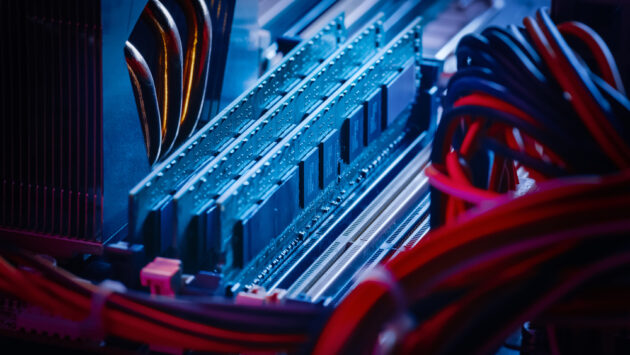Computer Memory is one of the most crucial components in modern IT Hardware and Computer Hardware systems. It plays a vital role in how fast and efficiently a computer can process data. While processors handle calculations, computer memory acts as the short-term storage where active processes and data are held for quick access. Without sufficient memory, even the most powerful computer hardware will struggle to deliver optimal performance.
In the field of IT Hardware, memory capacity and speed directly influence how efficiently a system can handle workloads. Whether you’re running office applications, designing graphics, or hosting a database, the performance bottleneck often lies in the amount and type of computer memory available.

The Role of Computer Memory in IT Hardware
When we talk about IT Hardware and Computer Hardware, memory stands out as a core performance driver. It acts as the workspace where active programs store the data they need in real time. The faster the memory, the quicker your computer can retrieve and execute instructions.
Computer Memory interacts closely with the CPU and storage devices. While storage (like SSDs and HDDs) retains data permanently, memory temporarily holds it for rapid access. This distinction is why computer memory is referred to as “volatile” — it loses all stored information when the power is turned off.
In high-end computer hardware setups, especially for gaming, video editing, and scientific simulations, memory speed and latency can make a significant difference in system performance.
Types of Computer Memory
Computer memory comes in different types, each with its own speed, structure, and purpose within a system. Understanding these types is crucial for making informed IT Hardware purchases and upgrades.
1. RAM (Random Access Memory)
RAM is the most common form of computer memory. It stores data that the CPU needs while performing tasks. RAM comes in several variants, such as:
- DRAM (Dynamic RAM): Requires constant refreshing to maintain data.
- SDRAM (Synchronous DRAM): Works in sync with the CPU clock.
- DDR, DDR2, DDR3, DDR4, DDR5: Each generation offers faster speeds and greater bandwidth.
2. SRAM (Static RAM)
SRAM is faster but more expensive than DRAM. It is mainly used in CPU caches and high-speed applications. Unlike DRAM, it doesn’t need constant refreshing.
3. ROM (Read-Only Memory)
ROM contains firmware and essential system instructions. It is non-volatile, meaning data remains stored even without power.
4. Flash Memory
Used in SSDs, USB drives, and memory cards, flash memory is non-volatile and much faster than traditional hard drives.
5. Cache Memory
Located inside or near the CPU, cache memory stores frequently accessed data to speed up processing.
How Computer Memory Works
Computer Memory works as a high-speed intermediary between the CPU and permanent storage. Here’s the typical data flow:
- The CPU requests data.
- If the data is in cache memory, it is retrieved almost instantly.
- If not, the data is fetched from RAM.
- If it’s not in RAM, it’s retrieved from slower storage devices like SSDs or HDDs.
This tiered memory structure ensures the CPU gets the data as quickly as possible, minimizing processing delays.
Importance of Memory Size and Speed
In Computer Hardware, both the capacity and speed of memory affect performance. Larger memory allows more programs to run simultaneously without slowing down. Faster memory reduces data transfer time between the CPU and RAM.
- Capacity: Modern computers typically come with 8GB, 16GB, or 32GB of RAM.
- Speed: Measured in MHz (megahertz) or MT/s (megatransfers per second), higher speeds improve data throughput.
- Latency: Lower latency means faster data access.
Memory in IT Hardware Applications
Different IT Hardware applications demand different memory configurations:
- Gaming: Requires high-speed RAM (DDR4/DDR5) for smooth graphics performance.
- Data Servers: Need massive memory capacity for handling multiple simultaneous requests.
- Creative Workstations: Benefit from both large memory size and high-speed modules for rendering and editing.
- Embedded Systems: Use low-power, efficient memory for specific tasks.
Choosing the Right Computer Memory
When upgrading or building a computer, selecting the right memory depends on:
- Compatibility: Check motherboard and CPU specifications.
- Capacity Needs: Choose based on workload — light tasks may need 8GB, while professional editing may require 32GB+.
- Speed Requirements: Match memory speed to CPU capabilities for maximum efficiency.
- Form Factor: Desktop and laptop RAM differ in size (DIMM vs. SO-DIMM).
Installing and Upgrading Memory
Installing computer memory is straightforward:
- Power off and unplug the computer.
- Open the case and locate the memory slots.
- Insert the RAM module firmly until it clicks into place.
- Close the case and reboot.
For laptops, access is usually through a dedicated compartment. Always consult the manufacturer’s manual for specific instructions.
Troubleshooting Memory Issues
Common memory issues include:
- System crashes or freezing: May indicate faulty RAM.
- Blue Screen of Death (BSOD): Often caused by memory errors.
- Slow performance: Could result from insufficient memory.
Tools like Windows Memory Diagnostic or MemTest86 can help detect faulty modules.
Future of Computer Memory
Memory technology continues to evolve:
- DDR5 and beyond promise even greater speeds.
- 3D-stacked memory improves capacity without increasing physical size.
- Optane and HBM (High Bandwidth Memory) are changing high-performance computing.
Conclusion
Computer Memory remains a vital component in the IT Hardware and Computer Hardware ecosystem. Understanding its types, functions, and performance factors allows users to make informed choices for building, upgrading, or maintaining systems. Whether you’re a casual user or a professional working with heavy workloads and business investing in the right computer memory ensures smoother, faster, and more efficient computing experiences.



